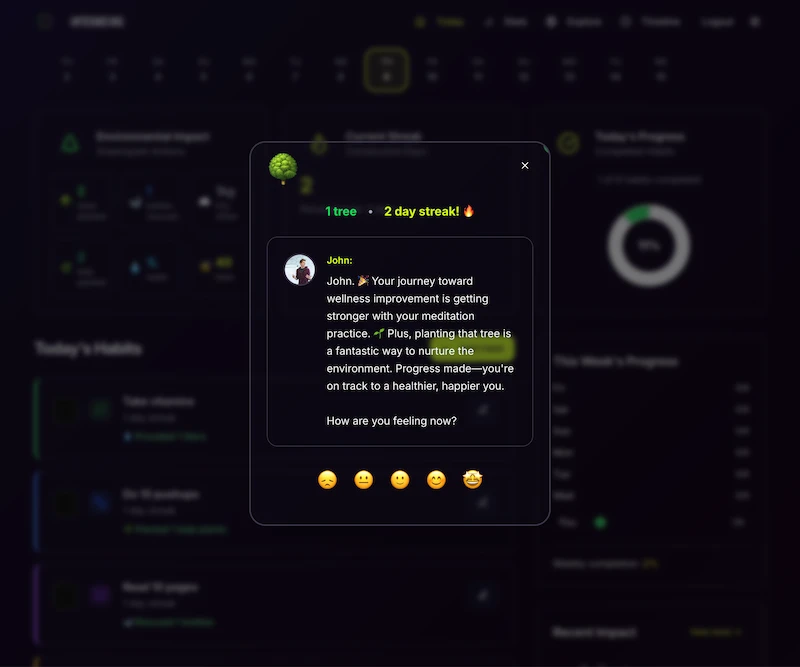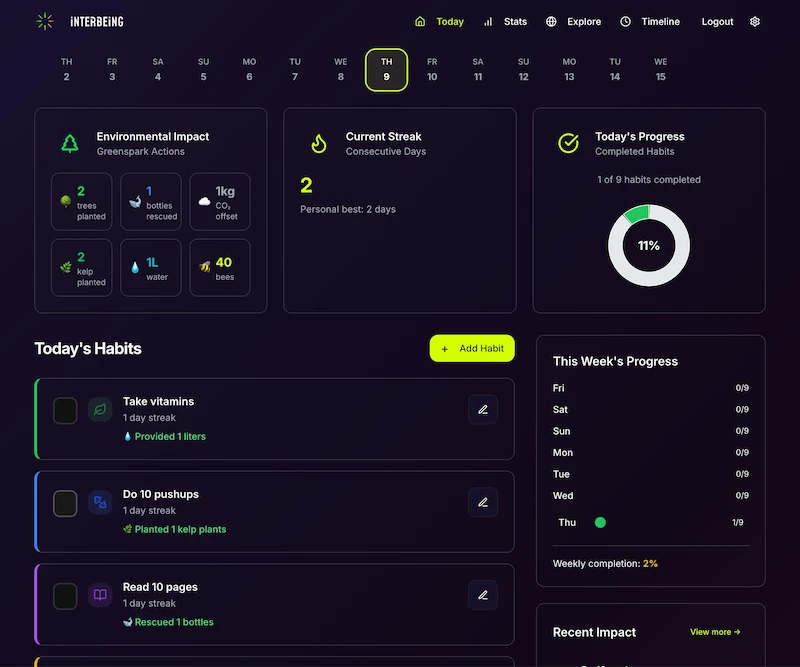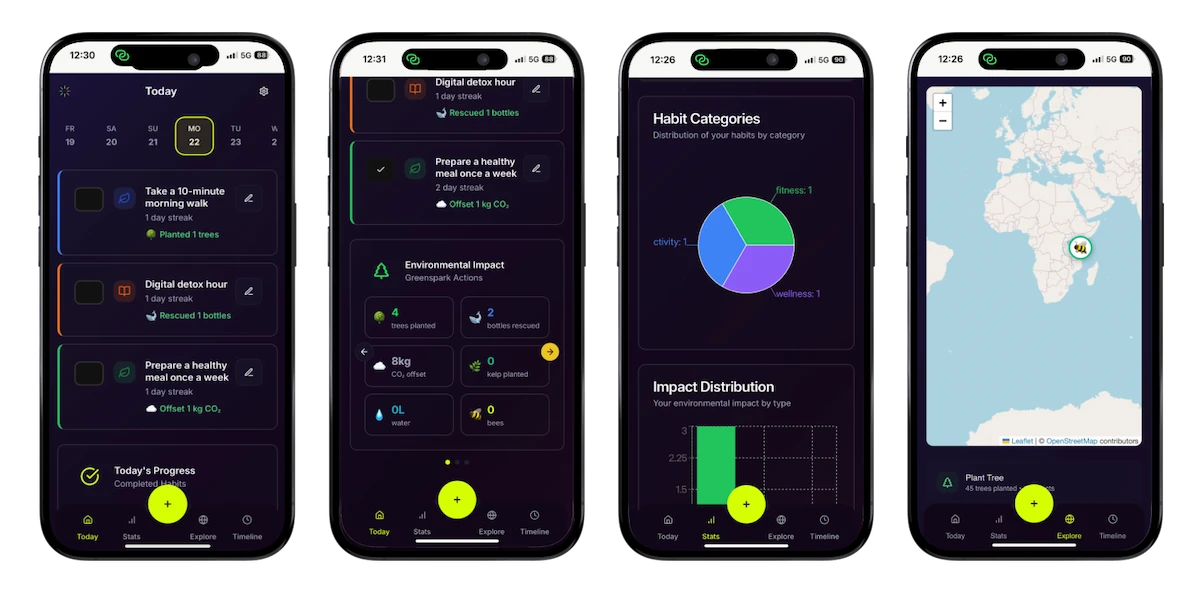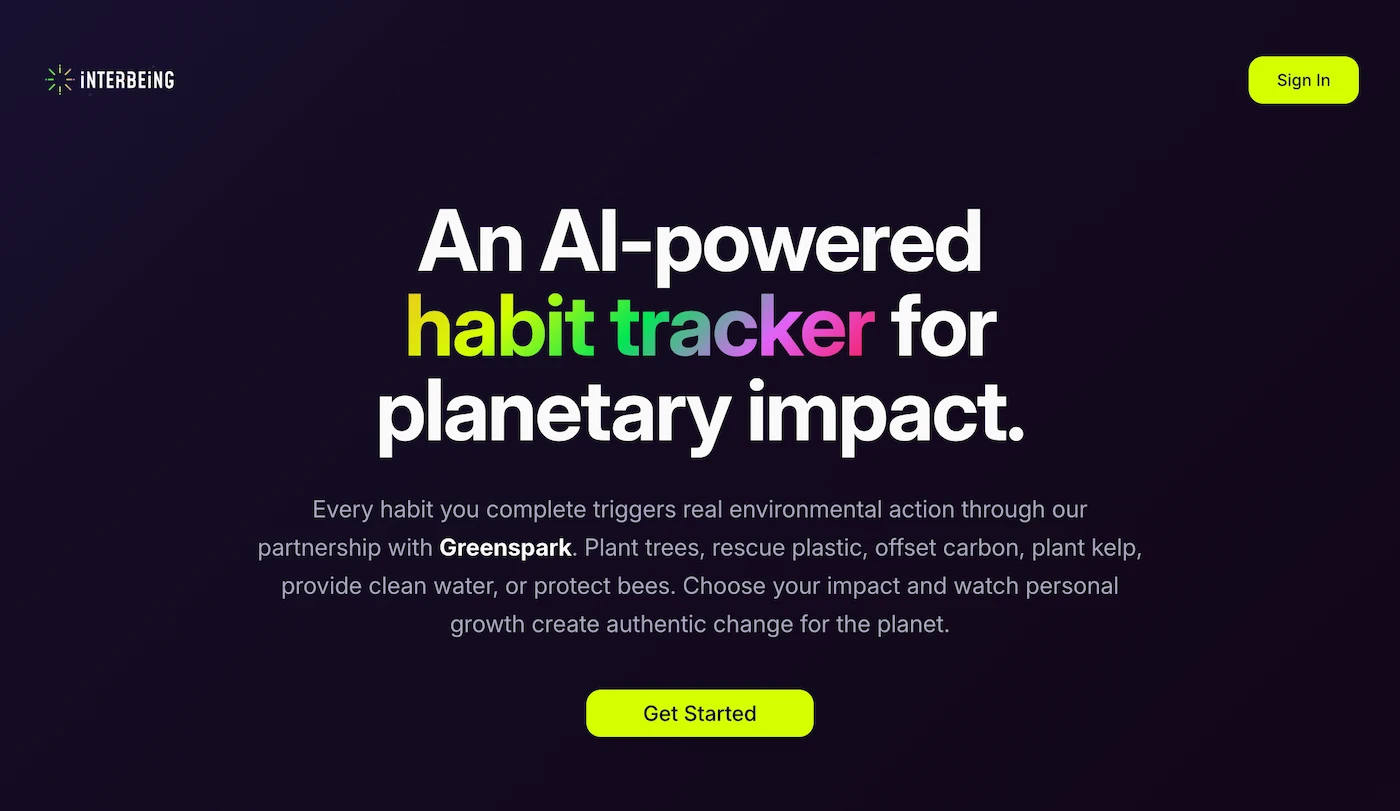Project Overview
Interbeing is a portfolio and learning project designed to push my skills as both a product designer and developer by shipping a vibe-coded AI habit tracker in record time.
The Concept
An AI-powered habit tracker that connects personal behavior change to verified planetary impact—see exactly where your trees are planted, plastic is removed, or bees are protected on a map.
The Challenge
Traditional habit apps focus only on personal achievement. Users seeking environmental impact can't verify where their contributions go or see tangible results.
The Solution
- 🧠 AI coaching based on BJ Fogg's Tiny Habits methodology
- 🌍 Automated impact actions through GreenSpark API (trees, plastic removal, clean water, bee protection, kelp)
- 🗺️ Real-time verification with map visualization
- 💆♂️ Emotional wellbeing tracking alongside behavior change
- 🏆 Personalized achievement system that adapts interface elements to individual goals
Technology Stack
Design & Development Process

Phase 1: Brand Development & Product Design (1 day)
Used ChatGPT for concept generation and Midjourney for visual inspiration. Built brand identity and product specs in Figma, including:
- 🎨 Complete visual identity and color system
- 📱 Mobile-first user flows
- 🗺️ Core screens: onboarding, habit tracking, impact map, timeline, emotion tracking
- 🏆 Personalized achievement system design

Phase 2: AI Coach Development (1 day)
Built custom GPT clone trained on BJ Fogg's Tiny Habits principles using a simple RAG implementation. The system queries a behavior design knowledge base before generating personalized recommendations.
Challenge: Integration complexity between RAG system and OpenAI API required significant debugging. Achieved functional AI coach but not as sophisticated as originally envisioned—hit the ceiling of what I could accomplish without deeper engineering expertise.

Phase 3: Core Feature Development (2-3 days)
- 🏋️♀️ Habit tracking with streak visualization
- 🌍 GreenSpark API integration for verified impact
- 📍 Interactive map showing contribution locations
- 📜 Timeline of all impact actions
- 💆♂️ Daily emotion tracking with trend visualization
- 🏆 Personalized achievement system using ChatGPT context to generate custom interface elements based on user goals
- 📊 Dashboard with at-a-glance overview

Phase 4: Testing & Iteration (1 day)
Personal testing, bug fixes, mobile optimization, and UI refinement based on usability issues.

Key Features
AI Behavior Coaching
Personalized recommendations grounded in evidence-based methodology out of Stanford University
Verified Planetary Impact
Tree planting, plastic rescue, clean water, bee protection and kelp planting via Greenspark. See exact locations on map, view timeline, track quantified metrics
Personalized Achievements
Custom interface elements that adapt to user's specific goals and celebrate milestones uniquely
Emotional Wellbeing
Mood tracking correlated with behavior patterns over time
Technical Challenges
AI Integration Complexity
The OpenAI integration and RAG system reached a complexity level that made exact outcome achievement difficult without deep code understanding. Required significant time investment to debug integration points. Achieved functional coach but not as sophisticated as envisioned.
Feature Complexity Threshold
As features accumulated, continued development in Replit became increasingly difficult. Learned that no-code/low-code tools are excellent for basic MVPs but hit limitations as complexity grows.
API Integration
Successfully connected to GreenSpark API with proper error handling and fallback UI states. It was more difficult to integrate with Greenspark API given their demo environment limitations, so I ended up having to do a lot of custom work on the API side which cost more in credits than it otherwise would've been to just pay for Greenspark!
Results & Learnings
What Worked
- Rapid prototyping: Concept to functional prototype in about one week of full-time equivalent work.
- Validated core hypothesis: Users get delighted by the concept of their habits planting trees, removing plastic from the ocean, etc.
- Skill development: Learned modern dev workflows, AI integration, behavior design principles
- AI-assisted development: Built features beyond my previous technical ability
What Didn't Work
- Didn't find a solution for covering the cost of planetary impact (corporate sponsors, etc.)
- Hit technical complexity ceiling without engineering support
- Replit hosting costs ($25/month) unsustainable for maintaining a long-term demo environment
Key Insights
Vibe coding is powerful for MVPs: Tools like Replit enable rapid hypothesis validation, but production applications require professional engineering, proper infrastructure, and scalable hosting.
Plan for complexity: Should have started with narrower feature scope. Complexity compounds quickly without proper planning.
Migration path matters: Needed a day-one plan with support from someone experienced in DevOps for moving from Replit to production environment.
If I Built This Again
Technology: Swift native iOS with Cursor/Claude Code
Process:
- Comprehensive product spec upfront
- Strict MVP boundaries (habit tracking + simple impact only in v1)
- Plan production architecture from beginning
- Bring in senior software engineer as coach for occasional paired programming sessions
Validation & Impact
Successfully Proved
- Technical feasibility of AI coaching + impact verification
- GreenSpark API provides reliable verification
- Concept resonates with users seeking meaningful habit tracking
- Behavior design principles can be programmatically implemented
Did Not Validate
- Willingness to pay for impact actions
- Long-term retention
- Pricing model
Reflections
This project demonstrated that the barrier to building has dramatically lowered—a non-engineer can build a multi-faceted application integrating AI, APIs, and complex user flows in two weeks with $80.
However, the path from prototype to production remains challenging. Vibe coding tools excel at hypothesis testing and learning, but production deployment requires professional engineering support and proper infrastructure.
Most importantly: I learned the current state of AI-assisted development firsthand, understanding both its incredible power and real limitations. The democratization of building means anyone can test ideas and solve problems, but sustainable, scalable applications still require professional engineering.
Project Status: Demo/Portfolio Project
View Demo
